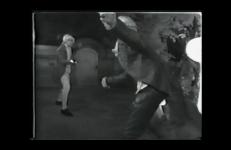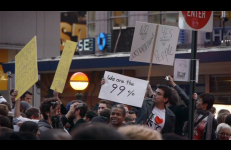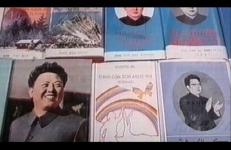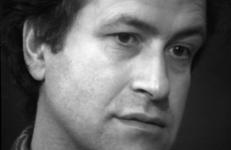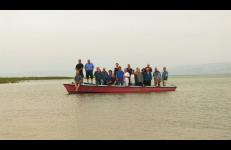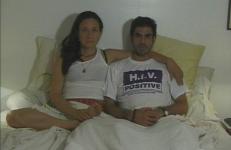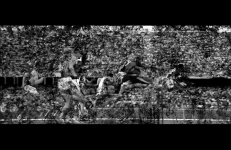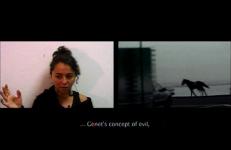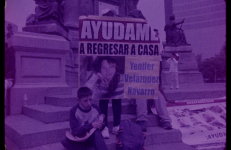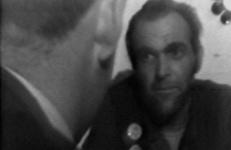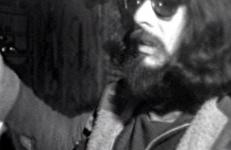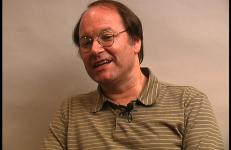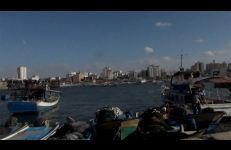Arguably, the most successful of the four “Gerald Ford’s America” shows was “Chic To Sheik,” a TVTV tour of the private culture of the official Washington. Lead by Megan Williams, they blithely move around an official White House tea for Betty Ford at the beginning and cavort at the Shah of Iran’s birthday party at the Iranian Embassy at the end. Shot with almost open access because this was when even public people, in private, were innocents before a documentary camera. Washington Post Society Editor, Betty Beale, leads the way. A gem.
Politics
In Glennda and Bruce Do Times Square, Glennda is taken on a night tour of Times Square by author Bruce Benderson. They observe the dynamic between forms of culture that would typically be identified as “underclass” in “suburbanite” culture within the economic and spatial landscape of New York City. Glennda and Bruce visit the apartment of performer Consuela Cosmetic, who was prolific within New York’s ball scene. She maps out the ways in which she believes gender can be expressed, and discusses the implications of ‘passing’.
In this video, Glennda Orgasm and social critic Camille Paglia walk the streets of downtown Manhattan and discuss the status of mainstream feminism in the early 1990s. They visit the Stonewall Inn, Washington Square Park, and a gay bookstore, and confront a group of anti-pornography protesters.
An episode of Glennda and Friends, hosted by Glennda Orgasm and Camille Paglia. Featuring The Centaurians, Brian Roach, and Rennard Snowden.
In this video, Glennda is joined by social critic and feminist scholar Camille Paglia in New York's fashion district. The pair visit designers studios to discuss their respective styles and creative processes. Additionally, Glennda and Camille explore fashion's relationship to gender and feminism, ultimately recreating an iconic scene from Breakfast at Tiffany's.
An episode of Glennda and Friends, hosted by Glennda Orgasm and Camille Paglia.
In this video, Glennda and sex activist Chris Teen attend the opening of Dress Codes at Boston's Institute of Contemporary Art. They interview museum staff, artists, and other attendees to explore how an exhibition centered upon gender nonconformity will be received by both queer communities and the general public. Glennda and Chris Teen discuss the importance of visibility for marginalized communities, and tap into gender discourses as they existed in the early 1990s.
In this video, Glennda Orgasm and Chris Teen travel to Washington, DC to attend a feminist art exhibition titled Walk the Goddess Walk at the District of Columbia Arts Center. The pair talk to the owner of the gallery, artists included in the show, and attendees, including Francy Caprino, Teena Cromwell, Andrew Melon, Camille Paglia, and Joseph Virgilio.
An episode of Glennda and Friends, hosted by Glennda Orgasm and Chris Teen.
In this video, Glennda and Judy LaBruce (Bruce LaBruce) visit the auction house Christie's East on New York's Upper East Side to view Judy Garland memorabilia that is being auctioned off. They attempt to rescue Garland's Oscar from those trying to profit from the auction.
An episode of Glennda and Friends, hosted by Glennda Orgasm and Judy LaBruce.
Gravity Hill Newsreels: Occupy Wall Street comprises Jem Cohen’s twelve-part series as a continuous and complete compilation. Cohen, who witnessed the New York occupation from day one, borrowed a digital camera and started gathering footage in subsequent weeks. Initially acting upon an instinctive impulse to document and be guided by the events of the movement through quiet participation, Cohen’s documentation took a more public and expansive form through an agreement with the IFC Center, a local movie theater.
Kim Jong Il, the Stalinist David O. Selznick, runs the state film studio as a way of promoting his own and his father's cult of personality. The film's title, Great Man and Cinema, comes from a propaganda booklet filled with stories of how the Dear Leader has written, edited, produced and given acting advice in films for the last 40 years. This film succinctly synthesizes the Dear Leader's directing philosophy with his feelings toward the imperialist beast at his heels.
Nurit Sharett visited the city of Hebron over the course of a year, teaching video art to a group of young Palestinian women. Over time the artist established firm relationships with three of her students and their families. The video documents everyday life in that microcosm, dissimilar to any other city.
Conceptual artist Hans Haacke’s two most notorious works took unsavory Manhattan real-estate dealing as their subject, which triggered the cancellation of his exhibition Real Time Social System at the Guggenheim Museum in 1971. With the conscientiousness of an investigative reporter, Haacke continues to scrutinize the rough edges between art and life.
A collection of unidentified individuals is stuck together on a boat. Are they going home? Where is their home and why are they so silent? This short work takes a look at a displaced and uprooted community.
Habit is an autobiographical documentary that follows the current history of the AIDS epidemic along dual trajectories: the efforts of South Africa’s leading AIDS activist group, the Treatment Action Campaign, struggling to gain access to AIDS drugs and the daily routine of the videomaker, a veteran AIDS activist in the U.S. who has been living with AIDS for more than ten years.
These are the ghosts of a haunted civilization, a culture of progress that hides the social and political horror behind the Olympic Games. These are the haunted figures in the Capitalocene era. A sinister dance of macabre abstraction. Part of the Hauntology series.
This video develops from a real event that took place during a theater seminar in the masters degree program at the University of Antioquia in Medellín, Columbia. The seminar occurred during one of the university's worst periods of violence. Two students in charge of a presentation on the life and work of French author Jean Genet decided to play a hoax on their fellow students - a hoax that involved an armed kidnapping. Their idea was to perform the ethos of Genet's work rather than to represent it in a conventional way.
Mother’s Day in Mexico is considered one of the most important family holidays of the year. Thousands of mothers have nothing to celebrate. They are the mothers of victims of forced disappearances. Mothers and relatives of the disappeared participated in the "March of National Dignity. Mothers searching for their Sons, Daughters and Justice."
In a conversation with one of the Hells Angels at a party the motorcycle gang has thrown in Manhattan, the interviewee introduces “Kenny, from the Videofreex” to his friends, commenting (presumably explaining the Videofreex project): “like low class society type shit.” At the Hells Angels party, the Videofreex exemplify their position as a documentarian group for alternative media, navigating the cramped space of the party to conduct interviews with members of the highly controversial Hells Angels group.
In February 1970, the Freex visit the garage of the Hells Angels to informally discuss American politics and motorcycle maintenance. In this video, David Cort leads an extensive interview with the group’s president, Sandy Alexander.
A suspension of events, they coexist and claim a kind of common temporality. A topological and architectural immersion.
A desktop video in five parts that modestly propose ways of existing with or against history and politics.
In this interview, Brian Holmes, an influential art critic, activist and translator, discusses social forms of alienation, human ecologies of power, and the impact of technology on geopolitical social networks. Holmes reflects on his ongoing study of the ways in which the rhetoric of revolution has been institutionalized, as well as artists’ resistance to such cooption. For him, artists working in collectives have the potential to create a new artistic milieu that is not aligned with the dominant model of production. This argument is born out in his published collection of essays, Hieroglyphics of the Future (2003).
Home Movies Gaza introduces us to the Gaza Strip as a mircrocosm for the failure of civilization. In an attempt to describe the everyday of a place that struggles for the most basic of human rights, this video claims a perspective from within the domestic spaces of a territory that is complicated, derelict, and altogether impossible to separate from its political identity.
"... Basma Alsharif’s Home Movies Gaza, a film that captures the impossibly politicized domestic sphere of the Gaza Strip, under the constant hum and buzz of overhead drones."
An eloquent personal narrative about the meaning of childhood and the use of children as political tools—specifically by “Right-to-Lifers” participating in the blockades of abortion clinics. Rather than merely constructing a video document of the daily drama surrounding the protests, Wrobel slows down the event and extracts the children's stories. She interlaces this with personal memories of her playful and carefree childhood, and exposes how she too was susceptible when young.
Adapted from psychologist A.R. Luria’s research in the Islamic outskirts of the Soviet Union in the 1930s, How to Fix the World brings to life Luria's conversations with Central Asian farmers learning how to read and write under the unfamiliar principles of Socialism.
Colorful digital animations based on Max Penson's photographs of collective farmers play against a backdrop of landscape images shot in Uzbekistan in 2004.




